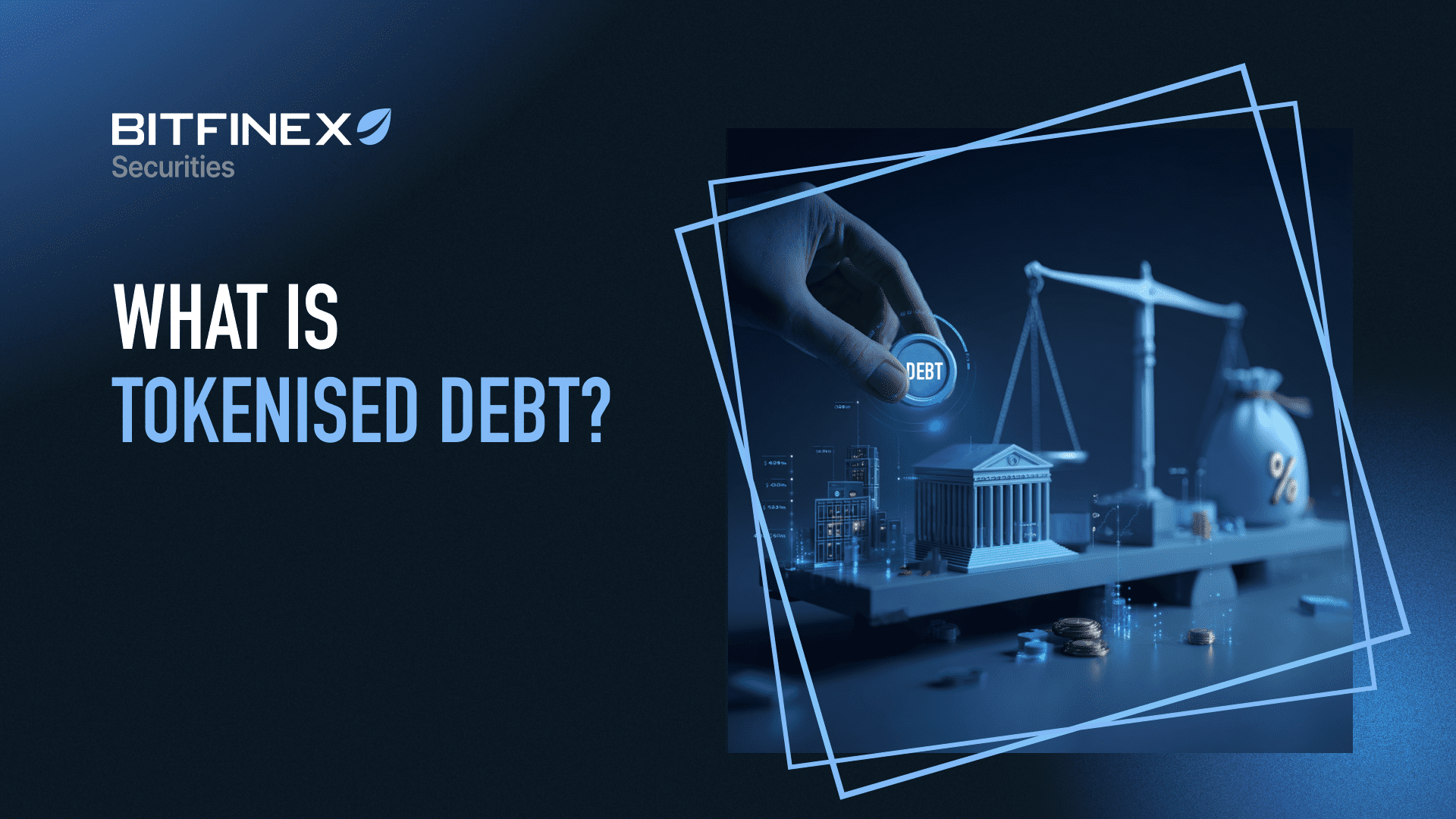
15 Oct What is Tokenised Debt?
This article is part of a series of features on tokenised securities.
Tokenised debt represents a decentralised evolution of traditional debt instruments, offering the same core economic purpose of raising capital while introducing efficiencies such as faster settlement, programmability, and fractional ownership. Unlike legacy debt markets that rely on multiple intermediaries and involve slow, complex processes, tokenised debt enables near-instant transfers, automated interest payments, and global investor participation. These innovations open opportunities for broader accessibility, lower costs, and enhanced transparency, though they also face challenges around regulation and jurisdictional compatibility. Platforms like Bitfinex Securities are at the forefront of this shift, pioneering tokenised debt offerings through collaborations with issuers worldwide with nearly $250 million in assets under management signalling the growing traction of this emerging sector.
How Does Tokenised Debt Differ From Traditional Debt Securities?
Tokenised debt refers to the representation of debt instruments, such as bonds, loans, or other fixed-income products, on a blockchain, sidechain, or Layer 2. Like traditional debt securities, tokenised debt establishes a contractual obligation for the issuer to repay borrowed funds with interest over time. What distinguishes it is the format: instead of existing as paper certificates or through custodial records managed by centralised entities, tokenised debt is issued and recorded digitally as blockchain-based tokens. These tokens can represent fractionalised units of debt, enabling smaller denominations and potentially expanding access to a broader range of investors.
One of the clearest differences between tokenised and traditional debt lies in the processes of issuance and settlement. Traditional debt securities usually involve an array of 3rd party intermediaries such as underwriters, custodians, and clearinghouses, with settlement times that can take days. Tokenised debt, by contrast, operates on-chain, where transfers and settlements occur directly between participants, often within minutes. Smart contracts can automate coupon payments, maturity redemptions, and compliance checks, reducing reliance on third parties and lowering administrative complexity. This design creates efficiencies, though it also introduces new considerations around regulatory compliance, which is still a very new and constantly changing environment.
Accessibility is another area where tokenised debt diverges from its traditional counterpart. The digital nature of tokens allows for fractional ownership, which can lower the entry barriers for investors who might not otherwise have the resources to participate in conventional bond or loan markets. Issuers, in turn, may gain access to new pools of capital around the globe by reaching investors across borders through digital asset offerings. However, this global reach raises questions around jurisdictional regulation, investor protections, and the compatibility of tokenised instruments with existing legal frameworks.
Tokenization also provides investors access to investments they would otherwise not be able to participate in. Tokenized US Treasury Bills, for example, are not widely available to investors in emerging markets, but can be purchased on Bitfinex Securities in $1 units. More niche assets like micro financing bonds provide investors with access to real-world business and return profiles not typically represented on conventional distribution channels.
Tokenised debt differs in how transparency and programmability are embedded into the system. With traditional securities, information flows through multiple intermediaries and records may be fragmented or delayed. Tokenised debt, however, enables real-time tracking of ownership and transaction history directly on chain. Programmability allows features such as automated compliance screening, whitelisting, and enforcement, conditional transfers, or even new forms of collateralisation that are not easily achievable in legacy systems. While tokenised debt shares the same fundamental economic purpose as traditional debt, providing issuers with capital and investors with predictable returns, the decentralised and open technological underpinnings and infrastructure create opportunities and efficiencies that set it apart from legacy fixed-income markets.
The Digitalisation of Legacy Debt Offerings Provides an Explosive Opportunity
The existing global securitised debt market is one of the largest and most established pillars of traditional finance, encompassing government bonds, corporate bonds, mortgage-backed securities, and a wide variety of structured credit products. These markets collectively amount to hundreds of trillions of dollars in outstanding value and form the backbone of global capital allocation, providing funding for governments, corporations, and infrastructure projects. However, the system is highly reliant on layers of intermediaries such as custodians, clearinghouses, and transfer agents, which add friction to issuance, settlement, and trading. Settlement can take multiple days, cross-border investment is complicated by regulatory and custodial hurdles, and access for smaller investors is often restricted. While mature and robust, the traditional model is defined by inefficiencies that limit flexibility and exclude large segments of potential participants.
By contrast, tokenised debt promises a streamlined alternative through disintermediation by moving issuance, settlement, and ownership tracking onto distributed ledgers. With token-based debt instruments, transactions can be settled near-instantly, while smart contracts automate interest payments and redemption schedules. This efficiency reduces counterparty risk and lowers operational costs, enabling issuers to reach investors more directly. In addition, fractionalisation of debt through tokenisation allows smaller denominations to be created, widening accessibility to less capitalised investors who would otherwise be priced out of bond markets. These features suggest that, if widely adopted, tokenised debt could significantly reshape how capital is raised and allocated, potentially expanding the size and depth of global debt markets.
The potential for growth in tokenised debt is amplified by the increasing interest from major financial institutions and governments in blockchain-based solutions. Central banks are experimenting with digital currencies, large asset managers are piloting tokenisation platforms, and regulatory bodies are beginning to establish frameworks for digital securities. This growing institutional attention signals a recognition that tokenisation could modernise debt markets in the same way that electronic trading transformed equities decades ago. If adoption snowballs (which many industry insiders are predicting), tokenised debt could scale from niche pilots into a mainstream financial instrument, unlocking liquidity in previously illiquid markets and lowering barriers for cross-border investment.
The comparison between the legacy debt system and the emerging vision of tokenised debt highlights a tension between legacy infrastructure and new technology. Traditional debt markets are vast, entrenched, and highly regulated, which gives them stability but slows innovation. Tokenised debt, on the other hand, is still in its early stages but offers efficiency, transparency, agility, and global reach that legacy systems cannot match. If adoption accelerates as many predict, the global debt market could undergo a profound transformation, with trillions of dollars migrating onto Bitcoin or Web3 rails. Such a shift would not only modernise debt issuance and trading but also redefine the accessibility and inclusivity of global finance in the coming decades.
Bitfinex Securities has Been a Trailblazer for Tokenised Debt Offerings
Bitfinex Securities is a central player in the development of tokenised securities, with a strong emphasis on tokenised debt as one of the most successful product categories. Through its regulated platforms in El Salvador and at the Astana International Financial Centre (AIFC) in Kazakhstan, Bitfinex Securities has provided issuers with a way to raise capital in a digital format while giving investors access to innovative, digital asset-based debt instruments. These offerings combine the familiarity of fixed-income products with the efficiency, security, and immutable transparency of the Bitcoin blockchain via Blockstream’s Liquid Network sidechain, making them attractive to both traditional investors and those already active in digital assets.
Among the most notable achievements of Bitfinex Securities are collaborations with issuers such as Mikro Kapital, Nexbridge, Blockstream, and Alternative (Luxembourg). These projects have demonstrated how tokenised debt can work in practice, enabling companies to issue debt instruments that are more efficient to trade, settle, and manage than conventional securities. By supporting these issuances, Bitfinex Securities has shown the viability of tokenisation as a tool for broadening capital access and providing investors with more flexible opportunities. The ability to fractionalise debt and facilitate global investor participation underscores how tokenised securities can lower barriers that are otherwise present in legacy financial systems.
Operating from dual hubs in El Salvador and Kazakhstan, Bitfinex Securities benefits from regulatory environments that have positioned themselves at the forefront of digital asset legislation. In El Salvador, it became the first firm to secure a license under the nation’s pioneering Digital Assets Law, a milestone that bears witness to its commitment to working within clear legal frameworks. At the AIFC in Astana, the company has been progressing through the regulatory sandbox and is now in the process of securing a full license, which will allow it to scale operations further. These strategic locations highlight Bitfinex Securities’ global approach to building a regulated infrastructure for tokenised debt and securities more broadly.
As a result of these efforts, Bitfinex Securities is nearing $250 million in listed assets, reflecting both growing demand for tokenised debt and the credibility it has established with issuers and investors. This trajectory suggests that tokenised debt, once seen as experimental, is gaining traction as a meaningful part of global capital markets. By combining regulatory compliance, successful pilot offerings, and a focus on scaling into fully licensed operations, Bitfinex Securities is positioning itself as a leader in bridging the gap between traditional finance and digital asset markets. Its role in this sector highlights how tokenisation could redefine debt issuance and investment for the decade ahead.



